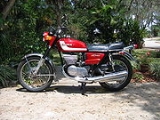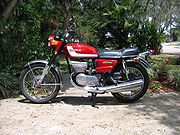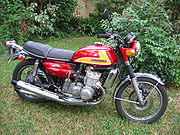
Suzuki GT series
Encyclopedia



Grand tourer
A grand tourer is a high-performance luxury automobile designed for long-distance driving. The most common format is a two-door coupé with either a two-seat or a 2+2 arrangement....
(GT) models in the strictest sense.
GT380, GT550, GT750
The initial lineup consisted of the following models:- GT380 Three cylinderStraight-3A straight-three engine, also known as inline-three engine, or a triple, is a reciprocating piston internal combustion engine with three cylinders arranged in a straight line or plane, side by side....
(marketed in North America as "Sebring") - GT550Suzuki GT550The Suzuki GT550 is a two-stroke, air-cooled, three cylinder 1970s-era motorcycle in Suzuki's "Grand Touring" GT series. Even though total production of the 550 exceeded 60,000 examples spread over a six model year production run, this total was exceeded by both of its three cylinder GT series...
Three cylinder (marketed in North America as "Indy") - GT750 Three cylinder (marketed in North America as "LeMans")
Engines
All engines were piston ported two-stroke types equipped with SuzukiSuzuki
is a Japanese multinational corporation headquartered in Hamamatsu, Japan that specializes in manufacturing compact automobiles and 4x4 vehicles, a full range of motorcycles, all-terrain vehicles , outboard marine engines, wheelchairs and a variety of other small internal combustion engines...
's proven, reliable and very economical Crankcase Cylinder Injection (CCI) multipoint oil injection system (previously known as PosiForce), conventional battery/points ignition system
Ignition system
An ignition system is a system for igniting a fuel-air mixture. Ignition systems are well known in the field of internal combustion engines such as those used in petrol engines used to power the majority of motor vehicles, but they are also used in many other applications such as in oil-fired and...
and chain-type final drive. The engines were designed following Suzuki's typical conservative design philosophy and featured classic Schnuerle porting. In a major departure for Suzuki, the alternator fitted was a three-phase excited field type using brushes and slip ring
Slip ring
A slip ring is a method of making an electrical connection through a rotating assembly. Slip rings, also called rotary electrical interfaces, rotating electrical connectors, collectors, swivels, or electrical rotary joints, are commonly found in electric motors, electrical generators for AC...
s with a wound rotor. A solid state
Solid state (electronics)
Solid-state electronics are those circuits or devices built entirely from solid materials and in which the electrons, or other charge carriers, are confined entirely within the solid material...
rectifier
Rectifier
A rectifier is an electrical device that converts alternating current , which periodically reverses direction, to direct current , which flows in only one direction. The process is known as rectification...
and a mechanical three-step regulator completed the system.
Up to this point, Suzuki had typically used a permanent magnet single phase alternator setup on its bikes so the new equipment was quite a step up for the GT series.
The 380 and 550 engines were air cooled with a system that Suzuki christened "Ram Air". This system consisted of a cast aluminum shroud covering a modified cylinder head
Cylinder head
In an internal combustion engine, the cylinder head sits above the cylinders on top of the cylinder block. It closes in the top of the cylinder, forming the combustion chamber. This joint is sealed by a head gasket...
to direct the cooling air.
The GT750, however, was liquid cooled. Suzuki thus led the motorcycle world by being the first company to mass produce
Mass production
Mass production is the production of large amounts of standardized products, including and especially on assembly lines...
a liquid cooled motorcycle - a big bore two-stroke The GT750 was quickly nicknamed the "Water Buffalo" in North America, the "Wasserbuffel" in Germany, the "Kettle" in the UK and the "Water Bottle" in Australia as signs of the affection felt by owners for this high torque two-stroke roadburner. This affection continues well into the new millennium with the GT750 having a large and loyal following worldwide dedicated to the reclamation and restoration of this unique machine.
Piston rings
Like all engines of this period, the 550 started life with chrome-plated piston ringPiston ring
A piston ring is a split ring that fits into a groove on the outer diameter of a piston in a reciprocating engine such as an internal combustion engine or steam engine.The three main functions of piston rings in reciprocating engines are:...
s running in cast iron
Cast iron
Cast iron is derived from pig iron, and while it usually refers to gray iron, it also identifies a large group of ferrous alloys which solidify with a eutectic. The color of a fractured surface can be used to identify an alloy. White cast iron is named after its white surface when fractured, due...
cylinder bores. However, for the 1976 MY, the 550 received a very forward thinking design change that featured cast iron rings running in chrome-plated cylinder bores.
This change was largely thanks to the RE5 which also used 'SCEM' (Suzuki Composite Electrochemical Material) in its combustion chamber - although their race dept may also have had an input.
Production and sales went along quite successfully from the initial 1972 introduction, no doubt helped by periodic updates and the introduction of the smaller capacity models for beginners.
Carburetors
An important change for the 1974 MY was the "unitizing" of the carburetorCarburetor
A carburetor , carburettor, or carburetter is a device that blends air and fuel for an internal combustion engine. It is sometimes shortened to carb in North America and the United Kingdom....
s on all of the three cylinder machines. For MYs 1972 and 1973 the carburetors had been three separate items with the complex cabling that such an arrangement entails. The unitized carburetors were mounted to a single bracket with a much less complex single push-pull cable arrangement. This arrangement allowed easier and more durable synchronization of the carburetors. This practice was continued through to the end of production of the three cylinder models. At this point the GT750 received the new Mikuni BS40 type diaphragm style carburetors. These proved to be somewhat troublesome but were eventually sorted out with some remedial jetting work in the field. All the smaller models stayed with the tried and true Mikuni VM type round slide carbs.
Exhaust system
Another feature differentiating the three cylinder GT models from their competitors was the bifurcation of the centre cylinder exhaust header. This allowed Suzuki to use four mufflers rather than the "unbalanced 2 and 1" arrangement used by the Japanese competition.....or the "three into two" exhaust arrangement favoured by the British manufacturers of three cylinder machines.Starting
The GT550 and GT750 also sported electric starting which is not truly necessary on a two-stroke engine, even ones as large as these. Apparently the sales department felt that the "electric leg" was a must-have item to keep up with the competitors. All other models, with the exception of the GT185, were kick startKick start
Kick start refers to a method of starting an internal combustion engine by pushing a ratcheting lever with one's foot. Kick start mechanisms were almost universally a part of motorcycle engines before the mid-1970s, and were phased out of production over the next twenty years or so as electric...
only.
Transmission
All models were equipped with five-speed transmissions with the exception of the GT380 which had a six-speed.Brakes
As well, all models were equipped with drum brakeDrum brake
A drum brake is a brake in which the friction is caused by a set of shoes or pads that press against a rotating drum-shaped part called a brake drum....
s front and rear. This arrangement only lasted for the 1972 MY. Suzuki did offer owners the option of a dealer implemented upgrade from the twin leading shoe drum front brake to a twin disc set-up but this was extremely expensive.
All of the 1973 MY three cylinder machines were equipped with hydraulically operated single disk brakes on the front while retaining their drum brakes on the rear. The GT750, however, had dual disks up front to cater for the braking requirements of this heavier and more powerful machine. This dual disk brake setup was another big "first" for Suzuki since all the competitors were using single front disks only at this time.
Design
All three GT models followed Suzuki's usual conservative design principles. The frames were all-welded mild steel tubing with long wheelbases to give stability at high speed.Colour schemes
Each of these models was available in two different colour schemes with the GT750 being available in three colours in most markets for the initial MY only. It reverted to two colour schemes for succeeding MYs. The engines were mildly tuned to produce more torque than the competition who were producing highly stressed machines with outright power for straight line performance. Suzuki was more concerned with durability and ease of use for its customers. The GT series of machines were large and substantial motorcycles designed for high speed highway riding following the tradition of European touring cars.GT380 for Italy
A marketing anomaly concerned the GT380. The actual engine displacement as introduced in the 1972 MY was 371cc and the 380 stayed this way until the end of production for most market areas. However, for the Italian market only, the GT380 received a displacement increase to 384cc starting with the 1975 MY. This engine size was continued through to the end of production for Italy alone. This was a counter to an Italian government import ban on bikes less than 380cc and less than 170 kg. Suzuki simply increased the bore of the GT380 to 55mm thus making the engine capacity now 384cc. Suzuki also made sure that the data plate riveted to the frame showed a weight of 171 kg.GT250
For the 1973 MY, the venerable T250 twin was updated with new bodywork, gained Ram Air cooling, a single disk brake in front and was now designated GT250. This model thus filled the important 250cc displacement slot in Suzuki's GT lineup. The GT250 retained its original engine and six speed transmission, both remaining basically unchanged from the T20 X6 Hustler of 1966 through the T250 model to the 1972 MY. The marketing name of "Hustler" was retained for the North American market.The GT250 continued on with minor changes until the 1976 MY when the engine was changed substantially, both internally and externally. Porting changes now saw the cylinders with four larger transfer ports instead of the previous two smallish ones as well as changes to the CCI system in the crankshaft main bearing area. The carburetors became 28mm in size instead of 26mm, the mufflers were modified to cater for the increased airflow through the engine and the transmission ratios were revised to more evenly match the new powerband. The Ram Air cover for the head was deleted and the stock finning on the heads was increased in height to gain the same effect as the Ram Air used to give.
GT185
Also for the 1973 MY, Suzuki introduced the GT185 twin cylinder model which was equipped with Ram Air cooling and drum brakes front and rear. It was marketed in North America as the "Adventurer". It also had a unique combination electric starter/generator setup. For the 1974 MY, the GT185 gained a single disk front brake to rationalize it with the other GT models. It then remained basically unchanged, except for colour and trim items (which included a tail fairing in the 1977 'B' model and cast wheels in the final year 1978 'EC' model), through to the end of production with the 1978 MY.In some markets the GT185 became the RG185 and was sold with different trim.
GT125
The 1974 MY also saw Suzuki introduce the GT125 to the motorcycling world. This model was similar in layout to the GT185 but with a shorter wheelbase and smaller engine displacement so shared only a few common parts. The rest of this model's equipment followed that of the GT185. The electric starter was deleted, probably in the interests of economy, which allowed a more attractive selling price in the very competitive "beginner" market that this model competed in. This model continued basically unchanged, excepting colours and trim items (the 'B' model in 1977 got a tail fairing), until the end of production with the 1977 MY.Some markets received 1978 MY (the 'EC' which had tail fairing & cast wheels) & there were MY 1979 & MY 1980 versions of this model with the name changing to RG125 X4.
The final GT125s were updated and sold with cast wheels and a tail fairing.
Suzuki listed the RG125 X4 in their sales literature until 1980 in continental Europe.
GT500
For the 1976 MY, the aging two cylinder T500 Titan was given a new front end with a single disk brake as well as freshened up bodywork. It was henceforth known as the GT500. The GT500 was discontinued at the end of the 1977 MY so had a very short production life. The GT500 was not graced with Ram Air cooling, probably because Suzuki already knew that their large capacity two stroke road bikes were reaching the end of their production lives. It was probably a way to get a few more sales dollars from what had now become a very dated design reaching back to the 1968 MY.Introduction of four stroke engines
With the 1977 MY Suzuki, bowing to the inevitable, had introduced its line of four stroke GS machines starting with the 750cc and the 400cc twin cylinder. These were soon followed by the 550 four cylinder and a little later the 1000 four cylinder models.The two strokes and four strokes were sold side by side for one MY.
The glory days of smooth and sophisticated two-stroke road machines came to an end with the 1977 MY.
Competition Machines
The Suzuki factory went racing at various levels with both the GT750 and the T500. The models were the TR750 and TR500 respectively.See also
- Suzuki GT750
- Suzuki GT550Suzuki GT550The Suzuki GT550 is a two-stroke, air-cooled, three cylinder 1970s-era motorcycle in Suzuki's "Grand Touring" GT series. Even though total production of the 550 exceeded 60,000 examples spread over a six model year production run, this total was exceeded by both of its three cylinder GT series...

